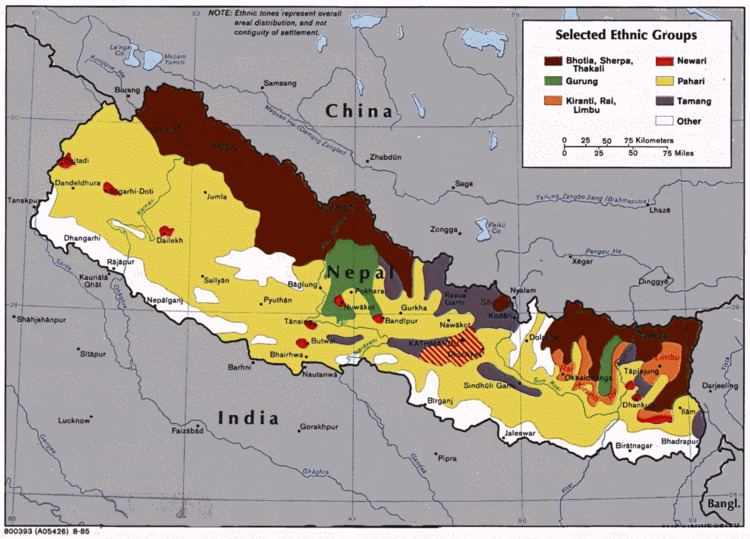Tamang (Devanagari: तामाङ; tāmāng) is a term used to collectively refer to a dialect cluster spoken mainly in Nepal, Sikkim, West Bengal (Mainly Darjeeling Districts - पश्चिम बङ्गाल राज्यको दार्जीलिङ जिल्लाको बिभिन्न भूभाग), Some parts of Assam and North East Region. It comprises Eastern Tamang, Northwestern Tamang, Southwestern Tamang, Eastern Gorkha Tamang, and Western Tamang. Lexical similarity between Eastern Tamang (which is regarded as the most prominent) and other Tamang languages varies between 81% to 63%. For comparison, lexical similarity between Spanish and Portuguese, is estimated at 89%. Tamang likely split from the Tibetan languages some time before the 7th century.
Ethnologue divides Tamang into the following varieties due to mutual unintelligibility.
Eastern Tamang: 759,000 in Nepal (2000 WCD). Population total all countries: 773,000. Sub-dialects are as follows.Outer-Eastern Tamang (Sailung Tamang)Central-Eastern Tamang (Temal Tamang)Southwestern Tamang (Kath-Bhotiya, Lama Bhote, Murmi, Rongba, Sain, Tamang Gyoi, Tamang Gyot, Tamang Lengmo, Tamang Tam)Western Tamang: 323,000 (2000 WCD). Sub-dialects are as follows.Trisuli (Nuwakot)RasuwaNorthwestern dialect of Western Tamang (Dhading) — separate ISO code. Population 55,000 (1991 census). Spoken in the central mountainous strip of Nuwakot District, Bagmati Zone.Southwestern dialect of Western TamangEastern Gorkha Tamang: 4,000 (2000 WCD). Sub-dialects are as follows.KasigaonKerounjaThe Tamang language is the most widely spoken Sino-Tibetan language in Nepal.
Ethnologue gives the following location information for the varieties of Tamang.
Eastern Tamang
Kathmandu DistrictJanakpur Zone: Sindhuli District, Ramechhap District, and Dolkha DistrictBagmati Zone: Kavrepalanchok District, western Sindhupalchowk District, Lalitpur District, Bhaktapur District, and eastern Nuwakot DistrictNarayani Zone: Makwanpur District and Chitwan DistrictSagarmatha Zone: Okhaldhunga District, western Khotang District, and Udayapur DistrictSouthwestern Tamang
Bagmati Zone: southern Dhading DistrictNarayani Zone: Chitwan District, northwestern Makwanpur District, Bara District, Parsa District, and Rautahat Districtwestern and northwestern Kathmandu District areaWestern Tamang
Bagmati Zone: western Nuwakot District, Rasuwa District, and Dhading Districtcentral mountainous strip of Nuwakot District, Bagmati Zone (Northwestern Tamang)northeastern Sindhupalchok District, Bagmati Zone: Bhote Namlan, and Bhote Chaur, on Trishuli river west bank toward Budhi Gandaki rivernorthwestern Makwanpur District, Narayani Zone: Phakel, Chakhel, Khulekhani, Markhu, Tistung, and Palungnorthern Kathmandu District: Jhor, Thoka, and Gagal PhediEastern Gorkha Tamang
south and east of Jagat, northern Gorkha District, Gandaki ZoneSome grammatical features of the Tamang languages include:
A canonical word order of SOVUse of postpositions;The genitives follow nouns;question word medial;It is an ergative–absolutive language;CV, CVC, CCV, V, CCVC;Phonetically Tamang languages are tonal.
Tamangic languages use Tam-Yig which is similar to Tibetan scripts and Devanāgarī. In many situations, however, Tamang is written in Devanāgarī proper.

